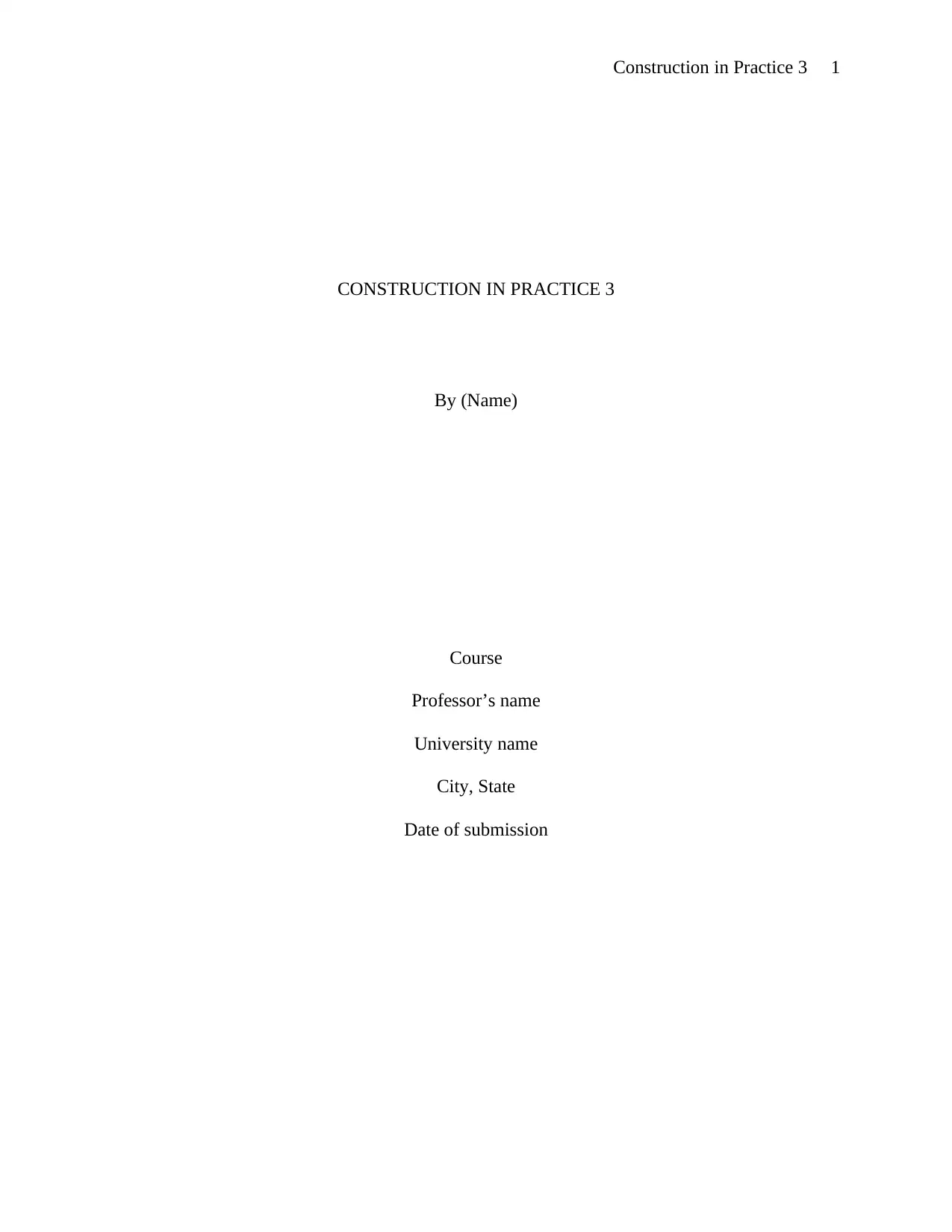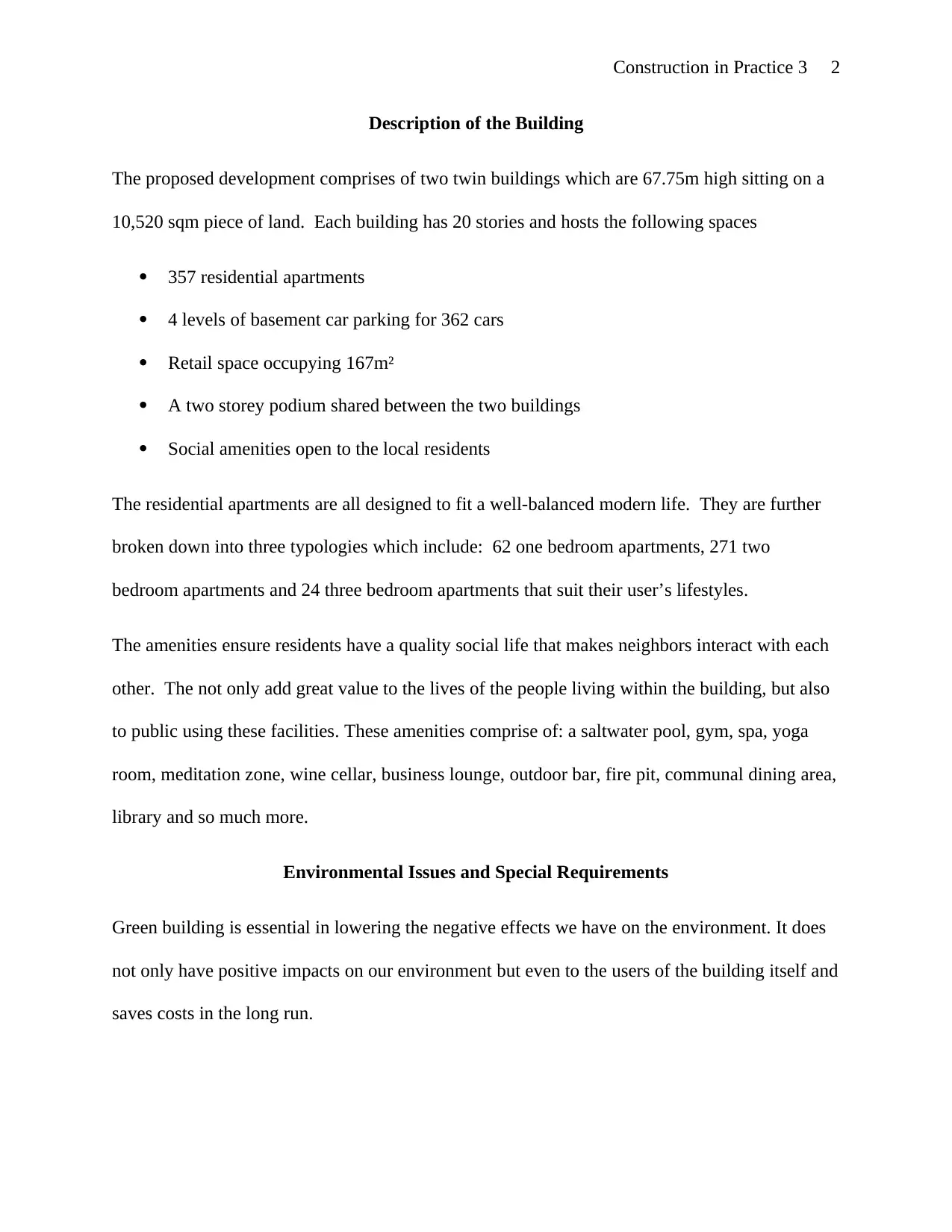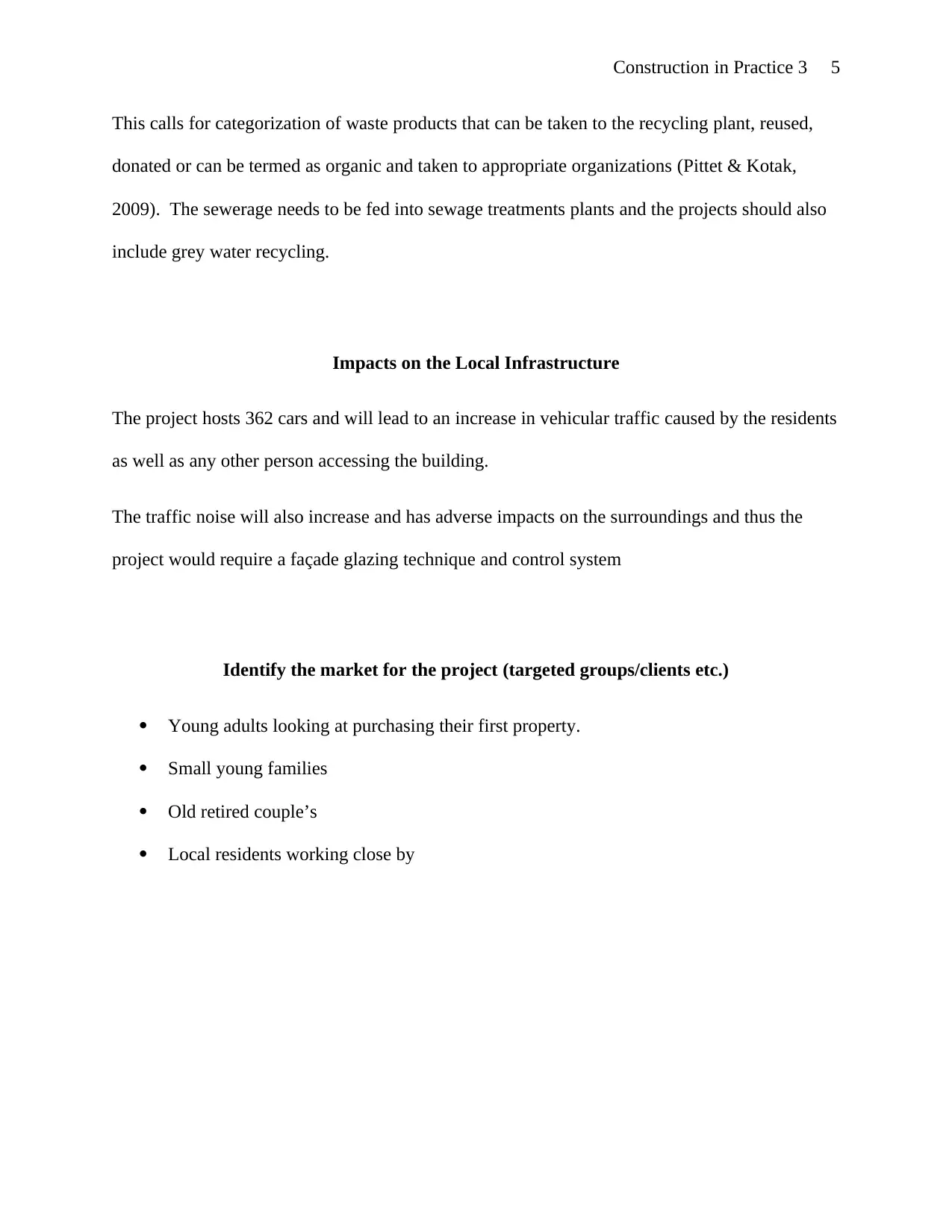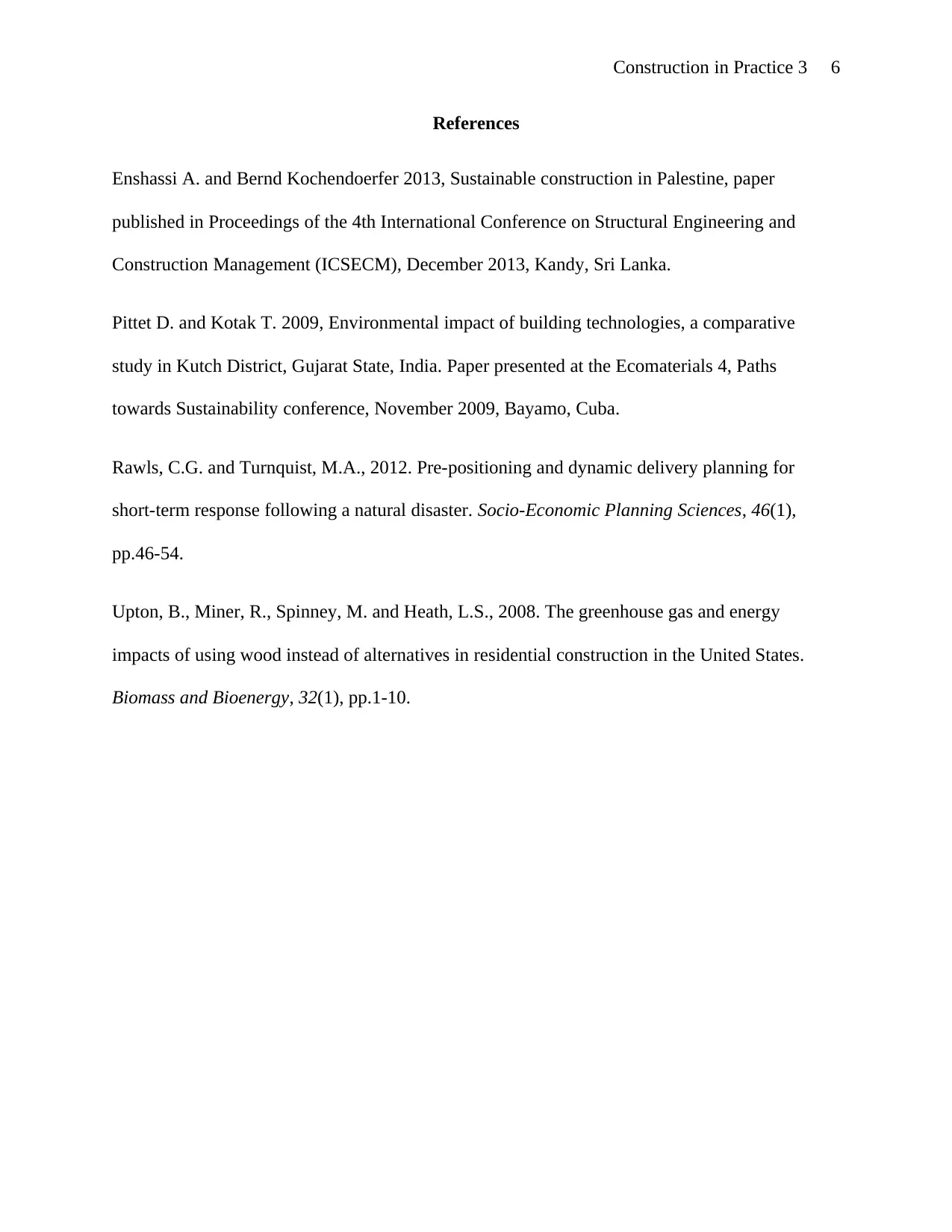Construction in Practice 3: Environmental Impact Assessment Report
VerifiedAdded on 2023/06/03
|6
|989
|397
Report
AI Summary
This report provides a comprehensive analysis of a proposed twin-building development, encompassing a detailed description of the building's design, including residential apartments, parking facilities, and retail spaces. It identifies and addresses critical environmental issues such as noise pollution, poor waste management, and rapid vibrations, proposing specific mitigation strategies like acoustic designs, waste categorization, and traffic management solutions. The report further examines the impacts on local infrastructure, particularly traffic, and analyzes the target market for the project, identifying potential clientele like young adults, families, and retirees. The document references several sources and offers recommendations for sustainable construction practices and environmental protection, making it a valuable resource for understanding the complexities of modern construction projects and their environmental and social impacts.

Construction in Practice 3 1
CONSTRUCTION IN PRACTICE 3
By (Name)
Course
Professor’s name
University name
City, State
Date of submission
CONSTRUCTION IN PRACTICE 3
By (Name)
Course
Professor’s name
University name
City, State
Date of submission
Paraphrase This Document
Need a fresh take? Get an instant paraphrase of this document with our AI Paraphraser

Construction in Practice 3 2
Description of the Building
The proposed development comprises of two twin buildings which are 67.75m high sitting on a
10,520 sqm piece of land. Each building has 20 stories and hosts the following spaces
357 residential apartments
4 levels of basement car parking for 362 cars
Retail space occupying 167m²
A two storey podium shared between the two buildings
Social amenities open to the local residents
The residential apartments are all designed to fit a well-balanced modern life. They are further
broken down into three typologies which include: 62 one bedroom apartments, 271 two
bedroom apartments and 24 three bedroom apartments that suit their user’s lifestyles.
The amenities ensure residents have a quality social life that makes neighbors interact with each
other. The not only add great value to the lives of the people living within the building, but also
to public using these facilities. These amenities comprise of: a saltwater pool, gym, spa, yoga
room, meditation zone, wine cellar, business lounge, outdoor bar, fire pit, communal dining area,
library and so much more.
Environmental Issues and Special Requirements
Green building is essential in lowering the negative effects we have on the environment. It does
not only have positive impacts on our environment but even to the users of the building itself and
saves costs in the long run.
Description of the Building
The proposed development comprises of two twin buildings which are 67.75m high sitting on a
10,520 sqm piece of land. Each building has 20 stories and hosts the following spaces
357 residential apartments
4 levels of basement car parking for 362 cars
Retail space occupying 167m²
A two storey podium shared between the two buildings
Social amenities open to the local residents
The residential apartments are all designed to fit a well-balanced modern life. They are further
broken down into three typologies which include: 62 one bedroom apartments, 271 two
bedroom apartments and 24 three bedroom apartments that suit their user’s lifestyles.
The amenities ensure residents have a quality social life that makes neighbors interact with each
other. The not only add great value to the lives of the people living within the building, but also
to public using these facilities. These amenities comprise of: a saltwater pool, gym, spa, yoga
room, meditation zone, wine cellar, business lounge, outdoor bar, fire pit, communal dining area,
library and so much more.
Environmental Issues and Special Requirements
Green building is essential in lowering the negative effects we have on the environment. It does
not only have positive impacts on our environment but even to the users of the building itself and
saves costs in the long run.

Construction in Practice 3 3
Pollution is the major long-term impacts the development has on the environment. Despite
having such adverse impacts on the environment, there are special requirements that can be put
in place to control and even solve these challenges.
Pollution
noise pollution
Rapid impacts of vibrations within the building
Outdoor entertainment
Traffic noise
Poor waste management
Poor management of solid waste, grey water and black water
Special Requirements
The building should include
1. special acoustic designs
These should put in consideration internal acoustics, that is, well insulated slabs or floors,
sound proof floors, double- glazed windows and so much more as well as external noise
control to ensure the surrounding residents are not disturbed.
Recessed electrical hardware, pipes as well as duct penetration systems should be
included to curb internal sound flanking.
Pollution is the major long-term impacts the development has on the environment. Despite
having such adverse impacts on the environment, there are special requirements that can be put
in place to control and even solve these challenges.
Pollution
noise pollution
Rapid impacts of vibrations within the building
Outdoor entertainment
Traffic noise
Poor waste management
Poor management of solid waste, grey water and black water
Special Requirements
The building should include
1. special acoustic designs
These should put in consideration internal acoustics, that is, well insulated slabs or floors,
sound proof floors, double- glazed windows and so much more as well as external noise
control to ensure the surrounding residents are not disturbed.
Recessed electrical hardware, pipes as well as duct penetration systems should be
included to curb internal sound flanking.
⊘ This is a preview!⊘
Do you want full access?
Subscribe today to unlock all pages.

Trusted by 1+ million students worldwide

Construction in Practice 3 4
Plants that have been spaced well are effective in lowering the noise levels in any interior
or exterior setting (Enshassi & Kochendoerfer, 2013). Live walls improve the air quality
of a space as well as its overall aesthetics
Outdoor entertainment areas create a significant noise disturbance to immediate residential
spaces (Upton, et al., 2008). This leads to loss of concentration and sleep disturbance for other
residents. Proper treatment of the building façade is required as well as strict adherence to noise
policies.
2. Rapid impacts of vibrations
The gym area is taken as an example and based its structure analysis, the following preliminary
recommendation are hereby proposed:
A neoprene or spring pad floor
Gym opening hours should be minimized to reduce sleep disturbance.
Reducing and limiting the utilization of the dumbbells and using a weight of no greater
than 30kg.
Creating a secondary slab above the existing floor structure of about ≥ 100mm in terms
of thickness.
3. Poor waste management
The project has to have a means of properly managing the waste of the residents. Improper
management of refuse collection and sewage impacts the environment negatively (Rawls &
Turnquist, 2012).
Plants that have been spaced well are effective in lowering the noise levels in any interior
or exterior setting (Enshassi & Kochendoerfer, 2013). Live walls improve the air quality
of a space as well as its overall aesthetics
Outdoor entertainment areas create a significant noise disturbance to immediate residential
spaces (Upton, et al., 2008). This leads to loss of concentration and sleep disturbance for other
residents. Proper treatment of the building façade is required as well as strict adherence to noise
policies.
2. Rapid impacts of vibrations
The gym area is taken as an example and based its structure analysis, the following preliminary
recommendation are hereby proposed:
A neoprene or spring pad floor
Gym opening hours should be minimized to reduce sleep disturbance.
Reducing and limiting the utilization of the dumbbells and using a weight of no greater
than 30kg.
Creating a secondary slab above the existing floor structure of about ≥ 100mm in terms
of thickness.
3. Poor waste management
The project has to have a means of properly managing the waste of the residents. Improper
management of refuse collection and sewage impacts the environment negatively (Rawls &
Turnquist, 2012).
Paraphrase This Document
Need a fresh take? Get an instant paraphrase of this document with our AI Paraphraser

Construction in Practice 3 5
This calls for categorization of waste products that can be taken to the recycling plant, reused,
donated or can be termed as organic and taken to appropriate organizations (Pittet & Kotak,
2009). The sewerage needs to be fed into sewage treatments plants and the projects should also
include grey water recycling.
Impacts on the Local Infrastructure
The project hosts 362 cars and will lead to an increase in vehicular traffic caused by the residents
as well as any other person accessing the building.
The traffic noise will also increase and has adverse impacts on the surroundings and thus the
project would require a façade glazing technique and control system
Identify the market for the project (targeted groups/clients etc.)
Young adults looking at purchasing their first property.
Small young families
Old retired couple’s
Local residents working close by
This calls for categorization of waste products that can be taken to the recycling plant, reused,
donated or can be termed as organic and taken to appropriate organizations (Pittet & Kotak,
2009). The sewerage needs to be fed into sewage treatments plants and the projects should also
include grey water recycling.
Impacts on the Local Infrastructure
The project hosts 362 cars and will lead to an increase in vehicular traffic caused by the residents
as well as any other person accessing the building.
The traffic noise will also increase and has adverse impacts on the surroundings and thus the
project would require a façade glazing technique and control system
Identify the market for the project (targeted groups/clients etc.)
Young adults looking at purchasing their first property.
Small young families
Old retired couple’s
Local residents working close by

Construction in Practice 3 6
References
Enshassi A. and Bernd Kochendoerfer 2013, Sustainable construction in Palestine, paper
published in Proceedings of the 4th International Conference on Structural Engineering and
Construction Management (ICSECM), December 2013, Kandy, Sri Lanka.
Pittet D. and Kotak T. 2009, Environmental impact of building technologies, a comparative
study in Kutch District, Gujarat State, India. Paper presented at the Ecomaterials 4, Paths
towards Sustainability conference, November 2009, Bayamo, Cuba.
Rawls, C.G. and Turnquist, M.A., 2012. Pre-positioning and dynamic delivery planning for
short-term response following a natural disaster. Socio-Economic Planning Sciences, 46(1),
pp.46-54.
Upton, B., Miner, R., Spinney, M. and Heath, L.S., 2008. The greenhouse gas and energy
impacts of using wood instead of alternatives in residential construction in the United States.
Biomass and Bioenergy, 32(1), pp.1-10.
References
Enshassi A. and Bernd Kochendoerfer 2013, Sustainable construction in Palestine, paper
published in Proceedings of the 4th International Conference on Structural Engineering and
Construction Management (ICSECM), December 2013, Kandy, Sri Lanka.
Pittet D. and Kotak T. 2009, Environmental impact of building technologies, a comparative
study in Kutch District, Gujarat State, India. Paper presented at the Ecomaterials 4, Paths
towards Sustainability conference, November 2009, Bayamo, Cuba.
Rawls, C.G. and Turnquist, M.A., 2012. Pre-positioning and dynamic delivery planning for
short-term response following a natural disaster. Socio-Economic Planning Sciences, 46(1),
pp.46-54.
Upton, B., Miner, R., Spinney, M. and Heath, L.S., 2008. The greenhouse gas and energy
impacts of using wood instead of alternatives in residential construction in the United States.
Biomass and Bioenergy, 32(1), pp.1-10.
⊘ This is a preview!⊘
Do you want full access?
Subscribe today to unlock all pages.

Trusted by 1+ million students worldwide
1 out of 6
Related Documents
Your All-in-One AI-Powered Toolkit for Academic Success.
+13062052269
info@desklib.com
Available 24*7 on WhatsApp / Email
![[object Object]](/_next/static/media/star-bottom.7253800d.svg)
Unlock your academic potential
Copyright © 2020–2025 A2Z Services. All Rights Reserved. Developed and managed by ZUCOL.




